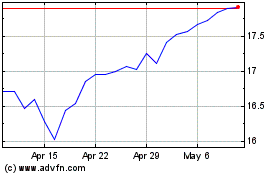By Russell Gold
PG&E Corp. conducted an unusual inspection of the power line
that sparked the deadliest wildfire in California history just
weeks before it failed, a step the utility has said it normally
takes only when it suspects a potential safety problem.
The disclosure that workers climbed portions of the
Caribou-Palermo line last fall, which PG&E noted in a recent
court filing, suggests the company had concerns about the condition
of its lines before the Camp Fire, which killed 86 people and
destroyed the town of Paradise.
The Nov. 8 fire is now being investigated by state and local
authorities, which could ultimately lead to criminal charges
against PG&E and its executives.
A PG&E spokeswoman said the company performed inspections of
about 80 towers on the Caribou-Palermo line before the Camp Fire as
part of a larger effort to determine "the condition of its aging
transmission lines." She declined to reveal the results.
PG&E lawyers first publicly mentioned the company had done
the inspections in a July 31 filing in federal court, following an
order by U.S. District Judge William Alsup to respond to a Wall
Street Journal article on maintenance of its power lines, paragraph
by paragraph.
In its disclosure, PG&E said the inspections occurred
between September and November last year and involved climbing the
transmission towers. Before the Camp Fire, which spurred the
company to conduct more exhaustive reviews of its power grid, it
was unusual for PG&E to climb its transmission towers to
inspect their condition, as well as the condition of bolts, hooks
and other hardware.
The results of the inspections were turned over to the
California attorney general's office, the Butte County district
attorney's office, and the California Public Utilities Commission,
all of which are investigating the cause of the Camp Fire,
according to PG&E spokeswoman Lynsey Paulo.
Ms. Paulo said the inspections didn't include the steel
transmission tower where a line fell from a hook and sparked the
Camp Fire. The closest tower inspected was more than 50 towers
away, a distance of roughly 7 miles, she said.
Even before these inspections, PG&E had placed
Caribou-Palermo on its "worst performing" list several times in
annual reports that tally unexpected outages. These reports were
sent to the regional electric grid operator, the California
Independent System Operator.
California fire investigators have concluded PG&E equipment
sparked the Camp Fire, and the company has said its equipment was
the likely cause.
A grand jury in Butte County, which includes Paradise, has been
empaneled to examine the evidence. The company and its executives
could potentially face criminal charges in connection with the
case, the state attorney general's office has said.
Asked if these inspection records were central to his
investigation, Mike Ramsey, the Butte County district attorney,
said: "All records are important. Some records are more important
than others."
The California attorney general's office and the Public
Utilities Commission declined to comment.
PG&E didn't mention the inspections in a lengthy federal
court filing at the end of 2018 in which it described ground-based,
aerial, infrared and lidar surveys of the line back to 2009. A
spokeswoman declined to say why.
Before the Camp Fire, PG&E said in the July 31 court filing,
it conducted climbing inspections of its transmission towers "in
response to specific 'triggering' events," such as defects
identified by inspection and component failure.
In 2010, a consultant hired by PG&E suggested that because
of the number of older towers, the company should consider climbing
them once every three to five years. PG&E didn't follow up on
the suggestion.
In an internal presentation from 2017, PG&E estimated that
its transmission towers were an average of 68 years old, and the
oldest were 108 years old.
This presentation also outlined PG&E's plans, in 2018, to
develop a method of prioritizing which towers represented the
highest risk to the public and should be replaced.
What PG&E knew about the condition of its aging lines --
including the 98-year-old Caribou-Palermo line that carried power
from hydroelectric power stations in the Sierra Nevada to more
populous regions to the south -- is expected to be carefully
scrutinized by investigators.
Most of the towers that PG&E inspected in September, October
and November were in the southern portion of the Caribou-Palermo
line, after it emerges from the Feather River Canyon and crosses
flatter, more accessible terrain around Oroville, Calif.
In the weeks after the Camp Fire, PG&E restarted the
Caribou-Palermo line. After further inspections, it decided to turn
it off permanently.
PG&E sought bankruptcy protection in January, citing $30
billion in fire-related liabilities, in one of the largest
corporate reorganization cases in years.
The embattled San Francisco-based utility, which provides
electric and gas service to one in 20 Americans, has said it
intends to file a restructuring plan by Sept. 9.
Write to Russell Gold at russell.gold@wsj.com
(END) Dow Jones Newswires
August 22, 2019 05:44 ET (09:44 GMT)
Copyright (c) 2019 Dow Jones & Company, Inc.
PG&E (NYSE:PCG)
Historical Stock Chart
From Mar 2024 to Apr 2024

PG&E (NYSE:PCG)
Historical Stock Chart
From Apr 2023 to Apr 2024
